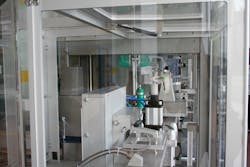Italy has a thriving machine building industry with a variety of companies specializing in many different technologies and industries. While all were concerned with weathering the economic crisis of 2009 and also with competition from China, they were also busy figuring out ways to maintain competitiveness and support green engineering.Marchesini Group S.p.A.’s (www.marchesini.com) 1,000-plus employees design and manufacture packaging machines--primarily for the pharmaceutical industry. Located in Pianoro, it is one of the largest packaging machinery builders in Italy. Responding to drivers for more flexibility, reduced energy consumption and integrated, smaller packaging lines, the company has incorporated much automation into its designs.Robots have been added to parts of the line proving to be flexible and economical. The transition to servo motion control for moving pieces of the machine has resulted in an average of more than 15 brushless servo motors per line. Software for track and trace of products during manufacture along with added data acquisition technologies means that Marchesini’s customers can monitor product quality better than before and, in the event of a product recall, limit the exposure to just those lots that are suspect.Packaging machines on the whole tend to be smaller and lighter. On the other hand, Sacmi Imola S.C. (www.sacmi.com) in Imola, a manufacturer of larger machines in the ceramics, beverage, packaging, processing and plastics industries, has invested in the High Efficiency Resource Optimizer (HERO) project as part of its efforts to help customers reduce consumption, improve efficiency and “go green.” HERO is a research laboratory dedicated to developing innovative technologies for achieving resource savings at every stage of the production process. The special applications developed as part of the HERO project enable energy consumption of the main machines to be reduced by more than 20 percent on average, with a view to more careful energy management. The economic benefits are therefore reflected in the company’s profits right from the first year of application, as part of a strategy of respect for the environment and constant raising of quality standards.The spray dryer is the major energy consumer in ceramic tile production. Sacmi has been researching for the past ten years using special numerical fluid dynamics calculation codes and in-the-field measurements into air delivery distribution and temperature profiles inside the hot air distributor and slip drying tower in order to find the problems and then the solutions. The hot air distributor with tangential-peripheral infeed developed by Sacmi improves heat exchange reducing fuel consumption.Keep heat inKeeping heat loss to outside air at a minimum is another energy efficiency goal. The hottest parts of the dryer are internally insulated with ceramic fiber resulting in lower air flow rates and higher infeed temperature than before. The dryers are externally insulated with thick layers of rock wool, while coupling flanges are insulated with ceramic fiber. Energy saving systems are integrated with machine control ensuring constant quality.Cogeneration systems and recovery of kiln fumes following depuration with lime and the dust separator slip heater have been designed to significantly reduce emissions of carbon dioxide, a key contributor to the greenhouse effect. Kiln fume recovery also reduces fluorine compound emissions; the advantage of this system is that the fumes are always filtered before being expelled through the chimney, even when the spray drier is at standstill.These are just two examples of how Italian machine builders take into consideration energy efficiency, environmental quality and customers’ needs as they design and build their equipment. Marchesini Group S.p.A.www.marchesini.comSacmi Imola S.C.www.sacmi.com
Sponsored Recommendations
Sponsored Recommendations
Leaders relevant to this article:

